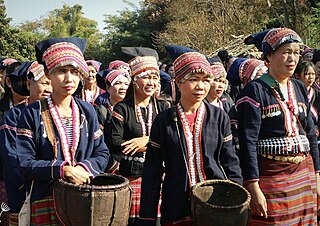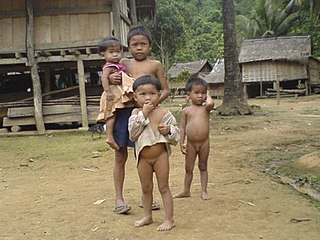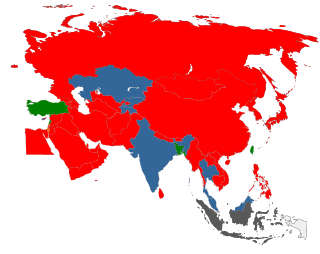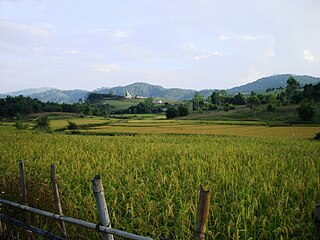
Muang Sua was the name of Luang Phrabang following its conquest in 698 by a Tai/Lao prince, Khun Lo, who seized his opportunity when the king of Nanzhao was engaged elsewhere. Khun Lo had been awarded the town by his father, Khun Borom, who is associated with the Lao legend of the creation of the world, which the Lao share with the Shan and other peoples of the region. Khun Lo established a dynasty whose fifteen rulers reigned over an independent Muang Sua for the better part of a century.
Khmu is the language of the Khmu people of the northern Laos region. It is also spoken in adjacent areas of Vietnam, Thailand and China. Khmu lends its name to the Khmuic branch of the Austroasiatic language family, the latter of which also includes Khmer and Vietnamese. Within Austroasiatic, Khmu is often cited as being most closely related to the Palaungic and Khasic languages. The name "Khmu" can also be seen romanized as Kmhmu, Khmu', Kammu, or Khamuk in various publications or alternatively referred to by the name of a local dialect.

The Khmu are an ethnic group of Southeast Asia. The majority (88%) live in northern Laos where they constitute the largest minority ethnic group, comprising eleven percent of the total population. Alternative historical English spellings include Kmhmu, Kemu, and Kơbru, among others.
The Monguor language is a Mongolic language of its Shirongolic branch and is part of the Gansu–Qinghai sprachbund. There are several dialects, mostly spoken by the Monguor people. A writing system was devised for Huzhu Monguor (Mongghul) in the late 20th century but has been little used.
The Khmuic languages are a branch of the Austroasiatic languages spoken mostly in northern Laos, as well as in neighboring northern Vietnam and southern Yunnan, China. Khmu is the only widely spoken language in the group.

Muang Xay, also referred to as Oudomxai or Oudomxay, is the capital city of Oudomxai Province, Laos.

The Lua people are a minority ethnic group native to Laos, although there is now a sizable community living in Thailand. Lua' is their preferred autonym (self-designation), while their Lao neighbours tend to call them Thin, T'in or Htin. Another term for this group is Lawa. There are two subgroups: the Mal and the Phai or Pray.

Khmuic peoples refers to a group of ethnic groups of Southeast Asia.
Jan-Olof Svantesson, born 1944, is a professor of Linguistics at Lund University, Sweden.
Torgut, also spelled Torghud, is a dialect of the Oirat language spoken in Xinjiang, in western Mongolia and in eastern Kalmykia. Thus, it has more speakers than any other variety of Oirat. It is better researched than any other Oirat variety spoken in China.
Bit is an Austroasiatic language spoken by around 2,000 people in Phongsaly Province, northern Laos and in Mengla County, Yunnan, China.
Alasha, or Alaša-Eǰen-e, is a Mongolic variety with features of both Oirat and Mongolian that historically used to belong to Oirat but has come under the influence of Mongolian proper. It has more than 40,000 speakers in Alxa League, Inner Mongolia, China and consists of two sub-dialects, Alasha proper and Eǰene.
Abag Banner is a county of Inner Mongolia, China. It is under the administration of Xilingol League. Abaga and Abaganar Mongols live here. The local dialect has variously been classified as Chakhar or Khalkha.
Nam Et-Phou Louey National Park is a protected area in northern Laos, covering 4,107.1 km2 (1,585.8 sq mi) in three provinces: Houaphan, Luang Prabang, and Xieng Khouang. It was designated a national park in 2019, and was previously designated a national protected area. The protected area included a 3,000 km2 (1,200 sq mi) core area where human access and wildlife harvest is prohibited and a 2,950 km2 buffer area where pre-existing villages are allocated land for subsistence living.

Prostitution in Laos is regarded as a criminal activity and can be subject to severe prosecution. It is much less common than in neighbouring Thailand. Soliciting for prostitution takes place mainly in the city's bars and clubs, although street prostitution also takes place. The visibility of prostitution in Laos belies the practice's illegality. As of 2016, UNAIDS estimates there to be 13,400 prostitutes in the country.

Xiangkhouang is a province of Laos on the Xiangkhoang Plateau, in the nation's northeast. The province has the distinction of being the most heavily-bombed place on Earth.

Oudomxay is a province of Laos, located in the northwest of the country. Its capital is Muang Xai.
The Angkuic languages are spoken in Yunnan province, China and Shan State, Burma.







